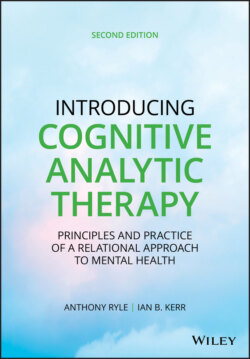Читать книгу Introducing Cognitive Analytic Therapy - Anthony Ryle - Страница 13
Оглавление
Preface to the Second Edition
This book offers an updated introduction and overview of the principles and practice of cognitive analytic therapy (CAT). The last such book appeared over 10 years ago and was the first systematic articulation of a new, integrative model which had been developed over a period of many years. Although there have been two specialist volumes since then (Ryle, 1995, 1997a) it is significant that a restatement of the model and its applications is now necessary. There are many reasons for this. They include the fact that as a young, genuinely integrative model (as acknowledged in the influential Roth and Fonagy report (1996)), it is still evolving and developing both in terms of its theoretical base and its range of applications. In this book, a further exposition of the CAT model of development is given, stressing in particular an understanding of the social formation of the self based on Vygotskian activity theory and Bakhtinian “dialogism.” We also outline an ever‐expanding range of practical applications of CAT as an individual therapy as well as its application as a conceptual model for understanding different disorders and informing approaches to their management by staff teams. This trend has been described (Steve Potter) as “using” CAT, as opposed to “doing” it. Newer or preliminary applications of CAT reviewed here include CAT in old age, with learning disabilities, in anxiety‐related disorders, in psychotic disorders, CAT for self‐harming patients presenting briefly to casualty departments, CAT with the “difficult” patient in organizational settings, and CAT in primary care. In part these also reflect theoretical developments of the model which are also reviewed. Its gradually expanding evidence base is also reviewed, along with some of the difficulties, both scientific and political, inherent in research in this area.
CAT evolved initially as a brief (usually 16‐session) therapy. This was partly for pragmatic reasons and related to the search for the optimum means of delivering an effective treatment to the kind of patients being seen in under‐resourced health service settings. However, it also arose from consideration and evaluation of which aspects of therapy, including its duration, were actually effective. This aspect of research is fundamental to the model and continues to be important in its continuing evolution. We suggest, incidentally, that a brief treatment like CAT, within the course of which profound psychological change can be achieved, genuinely merits the description of “intensive” as opposed to much longer‐term therapies usually described as such, which we suggest might better be called “extensive.”
Despite the effectiveness of brief CAT for very many patients, it is clear that not all patients can be successfully treated within this length of time. However, it is also evident from some very interesting work, with, for example, self‐harming patients but also less damaged “neurotic” patients, that effective work can also be done in a few, or even one session. The length of treatment has thus been modified to adapt to the needs of differing patients. Longer‐term therapy may need to be offered to those with severe personality disorder, longstanding psychotic disorder, or those with histories of serious psychological trauma. Thus, there will be some patients for whom the reparative and supportive aspect of therapy over a longer period of time may be an important requirement. Similarly, more extended treatments may be offered in settings such as a day hospital, where the treatment model may be informed by CAT, as an alternative to offering it as an individual therapy.
A further reason for the present book is the ever increasing popularity of CAT with mental health professionals and the demand from trainees and others for a comprehensive but accessible introduction to it. The rapidly increasing popularity of CAT with both professionals and patients is, we feel, a further indication of the effectiveness and attractiveness of the model. In part, we see this popularity as arising from the congruence of CAT with the increasing demand for “user participation” in mental health services; the explicitly collaborative nature of the model offers and requires active participation on the part of the client or patient. This “doing with” therapeutic position, in addition to being demonstrably effective, appears to be very much more appropriate and welcome to a younger generation of trainees and potential therapists. This “power‐sharing” paradigm has overall, in our view, radical implications for mental, and other, health services.
The CAT understanding of the social and cultural formation of the self also highlights the role of political and economic forces in the genesis of many psychological disorders. The external conditions of life and the dominant values of current society, internalized in the individual, are seen as active determinants of psychological health or disorder. Recognizing this, we suggest that, as therapists, we should strive to avoid describing psychological disorders as simply “illnesses” and should also play our part in identifying and articulating whatever social action may be called for in response.
The book is the result of the collaborative work of two authors who share responsibility for the text. Our contributions were different, in part because AR was the initiator of the CAT model and has a much longer history of writing about it. In so far as this conferred authority it also risked complacency which, he felt, needed to be challenged. IK brought a more recent experience of psychiatry and psychotherapy in the NHS, reflected in particular in the discussion of psychosis and of the “difficult” patient and contextual reformulation. He also wished to emphasize the importance of a full bio‐psycho‐social perspective. Our longest and most fruitful arguments were involved in writing the theoretical Chapters 3 and 4.
